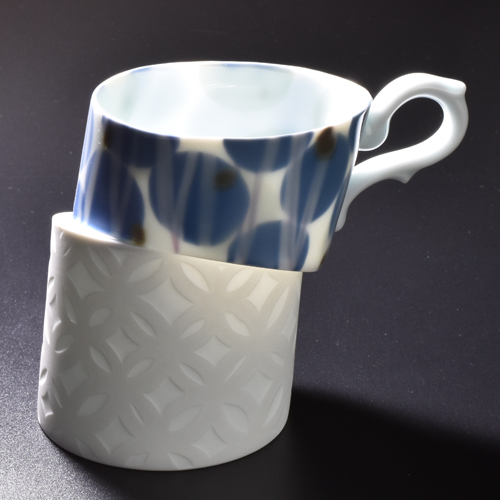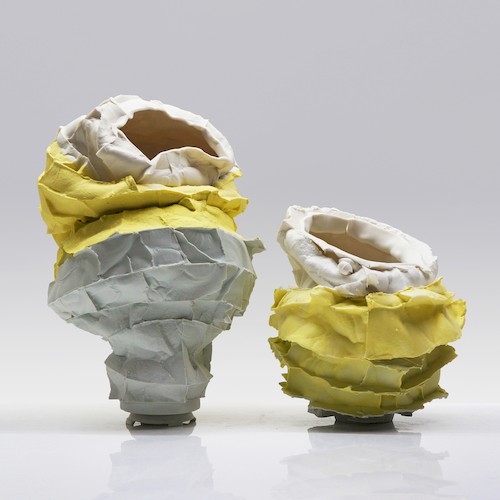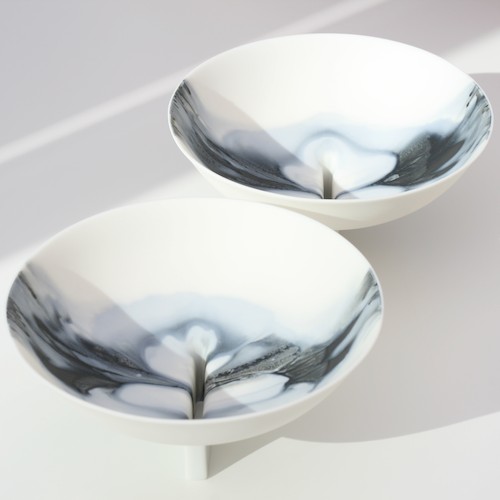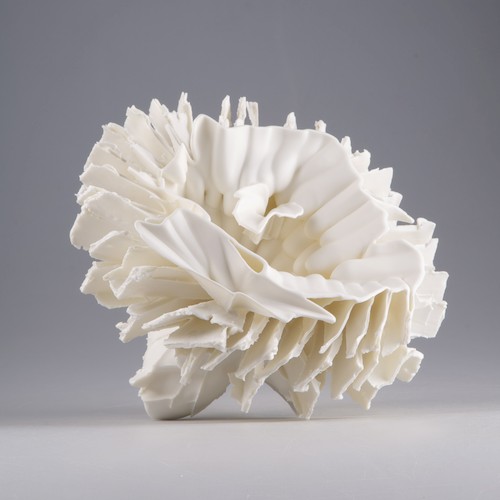
The art of slipcasting
25 September - 17 January 2021
Slip casted ceramics to be showed in all its forms. Made by a selection of ceramic artists from in and far outside the Netherlands. They prove that slipcasting is much more than just a reproduction technique. Their slipcasted pieces of art are astonishing. They vary from playful and inventive to technical and clean design to organic and whimsical.
The original idea of casting in clay was producing ceramics in series more quickly. Large numbers of exactly the same shapes, of which the makers’ casting edges and traces are carefully removed. This is the usual procedure in the ceramic industry regarding the production of services, vases, toilet bowls, washbasins, garden gnomes and much more… But there are other options as well! Unleash a number of artists on this technique and they will manage to make unique creations with them and develop astonishing variants on the method. The work they make using moulds and casting clay is surprisingly original and versatile.
For Hanneke Giezen (NL), the mould is her friend and workhorse. She casts numerous elements in her shapes, which she then plays with and mounts on top of each other. In this way she creates unique baroque images composed of countless numbers of little raccoons, shells and petals. For Johan Van Geert (BE), too, moving cast shapes about is a favourite pursuit, ranging en ordering his images until they become meaningful. A meaning that is often a reaction to events in the world, sometimes sad, sometimes with a wink.
Bomi Lee (KR) from Korea makes very modest subtle shapes. It looks as if they are made and of thin paper. She plays with cast shapes by making incisions in them after the casting and transforming them. The result is that no single piece by her is the same.
With Johannes Nagel (DE), too, each piece is unique and was made in a playful manner. He uses his hands to dig and shape, by touch in the sand, the negative casting moulds, into which he then casts the clay. The mould can be used only once. Thanks to this ánd thanks to the spontaneous intuitive creative process of the moulds in the sand, his work is miles away from licked and factory-made productions in large numbers.
Dik Scheepers (NL) also uses his intuition in his work. He has developed methods in which complex shapes can be cast in a mould only consisting of one part. The more directly he can work, the better. He has also made a service series under the name of “Pieces of Pi”. It has irregular facets and casting edges. They have not been finished deliberately so that the production process can still be seen. Thus the work clearly distinguishes itself from clearly finished series products.
The deliberate leaving of casting edges is also to be found in the work of Monika Patuszynska (PL) and Zsolt József Simon (HU). With Monika, this results in baroque piling, her works are dynamic sculptures looking as if they have been piled up carelessly and as if they can tumble down any minute. With Zsolt József, the casting edges have grown into a jumble of enormous prickles and ribs. The original shape is no longer recognisable. His work belongs to a totally different world than that of solid reproduction work, it reminds one of organic plant forms such as corals, pineapples or thistles.
Then there are the artists who use the casting technique to create solid geometric objects that can’t possibly be made with any other ceramic technique. Andreas Steinemann (CH), for instance, makes shapes reminding one of solid origami, ingeniously folded paper vases. However, it is still absolutely real ceramics! Mieke De Groot designs staggeringly complicated structures on the basis of geometric shapes. She first makes them from polystyrene, casts moulds of them and from those moulds she forms the different parts which finally she composes into a great sculpture. Especially for this exhibition, she has also developed work that cán be cast in one go. Here, too, the origin of complex skins and structures can be recognised. Lea Georg’s work (CH) is a beautiful play with shape and residual form with positive and negative. Her objects fit together like pieces in a puzzle or, in this context, like perfect multi-part casting moulds.
Arnold Annen (CH) and Sasha Wardell (GB) play with thin layers and transparency. Both of them work with the translucency of porcelain. Arnold provides his paper-thinly cast bowls with beautiful skins along which the light can play. Sasha Wardell casts several layers of porcelain in different colours on top of one another, and after that partly cuts away layers so that the underlying colours become visible. The fresh tints and bright shapes are a treat for the eye. The taste buds are also triggered because the different pastel layers remind one of sweets and gobstoppers.
Margot Thyssen (BE) also works with thin layers. While casting she constructs her objects with different bright tints of porcelain. In addition, other work by her shows, in a beautiful way, casting in different tints of porcelain that flow into and across one another. Olav Slingerland (NL), too, cleverly plays the game with casting and moulds. He develops his moulds and prototypes with other materials. In this way, he manages to create shapes that are unreal and asymmetric for ceramics, which, especially in series, yield an impressive image.
Finally, there is a number of exhibitors that are close to functional ware but give a personal and an artistic twist to it, such as Vladimir Groh & Yasuyo Nishida (CZ/JA): their decorative and functional objects consist of cut shapes playfully mounted on top of one another and provided with beautiful decorations, with each of them clearly putting their own marks on the objects as regards style: a great combination of these partners in love and in clay.
Opening
The exhibition opens at 16:00 on Friday 25 September 2020. Due to the Corona measures, the opening will be organised in an alternative way. Conservator Sacha Odenhoven will present the introduction, which can be watched at a distance, during or after the exhibition.
Participating artists
Arnold Annen (CH); Johan Van Geert (BE); Lea Georg (CH), Hanneke Giezen (NL); Vladimir Groh & Yasuyo Nishida (CZ/JA)); Mieke de Groot (NL); Bomi Lee (KR); Johannes Nagel (DE), Monika Patuszynska (PL); Dik Scheepers (NL); Zsolt József Simon (HU); Olav Slingerland (NL); Andreas Steinemann (CH); Margot Thyssen (BE); Sasha Wardell (UK).
Presentations
The artists below will be present in person during the exhibition and give demonstrations, lectures and/or guided tours: Would you like to attend a presentation? Due to Corona, we ask you to book a place on our website in advance.
- 29 November 13.30-16.30 h: uur: Dik Scheepers (NL)
- 27 December 13.30-16.30 h: Mieke de Groot (NL)
- 3 January 13.30-16.30 h: Johan Van Geert (BE)
- 10 January 13.30-16.30 h: Olav Slingerland (NL)
- 17 Januaryi 13.00-17.00 h: Vladimir Groh & Yasuyo Nishida (CZ/JA)
Workshops
Workshop given by exhibitor:
6 February 10:00-16:00 h Margot Thyssen (BE)




